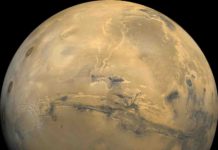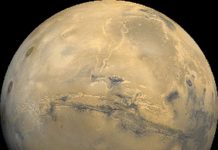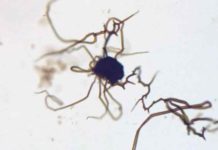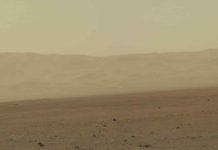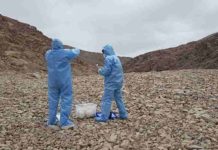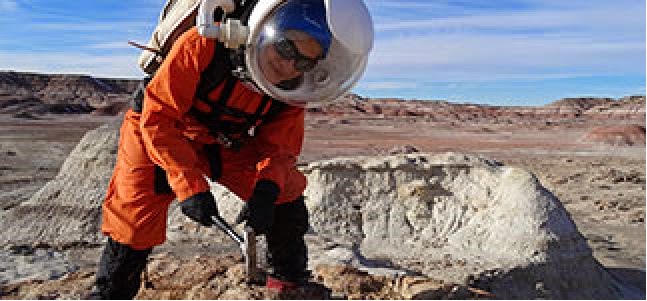
Some scientists may dream of the chance to pursue their research on another planet. That opportunity isn’t a reality just yet, but PhD student Michaela Musilova got the next best thing – a simulated mission to Mars.
Space suit fitted: check. Helmet secured: check. Radio transmitter attached: check. Air supply pack turned on: check. Time to go into the airlock! While the simulated depressurisation of the airlock is ending, my fellow crewmember and I finish making our plans for the EVA – extra vehicular activity.
I look through the porthole eagerly, in anticipation of stepping out onto the Martian terrain. It’s another sunny day on Mars, even though the temperature is still below zero. It’s a good thing our suits are thick enough to protect us against the cold, but that makes them very heavy: along with the air-supply pack they weigh 15kg.
As I walk over the rolling, red sandy hills of the stunning Martian landscape, I look back at the Mars Desert Research Station (MDRS). It is an analogue (simulation) laboratory – a copy of a planned NASA surface base on Mars – built by the non-profit Mars Society, which works closely with NASA and other international space agencies.
The station is in the high, cold Utah desert, USA, where the environmental conditions, geological features and biological attributes are a good approximation of what we know about those on Mars. It was designed to help people learn about the challenges of living and working on Mars. The Red Planet is considered to be the nearest planet with the resources for humanity to inhabit and then to use as a stepping stone for expansion further into the universe.
I am one of several scientists selected to take part in a total immersion simulation for over two weeks. This means we spend every minute of every day facing the physical and social challenges of life as we would experience it on Mars.
We are here as analogue astronauts, subjected to psychological, nutritional and scientific studies designed by researchers from around the world. These include living with limited amounts of electricity, oxygen, water and dehydrated powder-like astronaut’s food. Crews for simulations are selected to include specialists in different fields of research that would be necessary for the exploration of Mars.
Our crew commander is an aerospace engineer; we have a medical officer, two crew engineers, each specialising in a different aspect of space technology equipment testing; two crew scientists: a geochemist and myself – an astrobiologist and geologist. We also have a film-maker and even a humanoid robot, which we are testing out as a potential crew-member for real Mars missions.
We arrived at MDRS on 18 January 2014 and spent every moment of the simulation in total isolation from our terrestrial lives. The facility became our new home. It is made up of a habitat module nick-named the Hab, a greenhouse called the GreenHab and an observatory. The Hab is a two-storey cylinder-shaped building made to fit atop a heavy-lift space-launch vehicle. It’s only eight metres in diameter, creating a very confined living and working environment.
The common room, on the top floor, also serves as dining room, workstation, kitchen and exercise area. The lower level contains the airlock, laboratories, bathroom and toilet, all crammed into a space the size of my living room. As a consequence, you are almost always within eyeshot and earshot of at least one other person, so, it was really important that the crew could work as a team and get along for a prolonged period despite the lack of privacy.
Each of us has our own scientific experiments to conduct, which involve lab and/or field work in the simulated Martian environment. They include field-testing NASA hardware that extracts hydrogen and oxygen from soil, a technology that could potentially produce breathable air, drinkable water and rocket fuel for a return journey to Earth. If it works, this equipment would dramatically reduce the weight and cost of future space missions.
Our team also carried out simulated surgeries, via Skype, with several research groups around the world including the French/Italian Concordia base in Antarctica. The goal of these ‘tele-surgeries’ was to understand the difficulties faced when medical experts have to direct non-experts in an emergency, with restricted and delayed telecommunications – a situation astronauts travelling to Mars are likely to find themselves in.
One of the engineering projects is on prototype spacesuit glove technology. Our gloves have to be thick but these prototypes are nevertheless designed to feed information to the user’s fingertips about the texture and temperature of what they are holding, giving the astronaut a better awareness of the samples they are handling and the environment around them.
Another engineering project is testing rover cameras and a 3D mapping system similar to the one that will be on the ExoMars rover (scheduled for launch to Mars in 2018).
My own research is on extremophiles: organisms that live in physically or chemically extreme environments and are therefore significant for understanding what kind of life might exist on other planets and to help us develop the technologies to search for it. At MDRS, I am investigating two important questions: whether terrestrial microbes can survive in Mars-like conditions and thus whether there could be similar life on Mars; and whether these extremophiles could be used for terraforming Mars – recreating Earth-like conditions. Without terraforming or some other way of creating conditions for agriculture on Mars we could never properly settle on the Red Planet.
Today, I set out to collect more extremophiles for my experiments in the Hab (and for further analysis during my PhD). I love doing this simulated Martian fieldwork. Regardless of how hard it is to move around in my heavy spacesuit, breathing artificial air in my fishbowl helmet, I am completely absorbed in my role as an analogue astronaut. Walking towards the red Martian hills on the horizon I feel, more than ever, that I am on the path towards my childhood dream of going into space for real.
Note : The above story is based on materials provided by © Natural Environment Research Council




